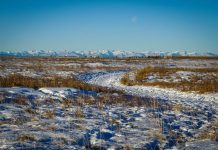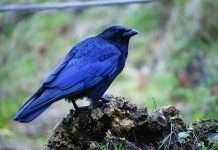Long ago, what we know as Alberta was underwater, covered by the ocean and surrounded by tropical forests. As many as 20 major glacial advances and retreats reshaped the landscape, including the continuous plateau of Nose Hill and Lake Calgary. Nose Hill provides spectacular views of the Bow River Valley and the uplands across the valley. Their geological history began in the floodplain of the Bow River which flowed at the top level of the present Hill where the river deposited gravel, sand, and mud. These are relatively thin on the steeper slopes. Nose Hill is bounded by the overflow spillway system, now Beddington and Nose Creek. Big Hill Springs Coulee is what remains.
Erratics are stones, boulders, or big blocks picked up and moved from one place to another during the last ice age. There are many in Nose Hill Park traced to a landslide from Mount Edith Cavell in Jasper National Park; they are part of a series across the Foothills region of Alberta. The Foothills Erratics Train runs from near Hinton, Alberta, to the Montana border. Some large boulders, such as the Nose Hill Buffalo Rubbing Stone, were used centuries ago. You can hike up to the Nose Hill 64 Avenue Glacial Erratic from the parking lot off 14 Street NW. At the top of Nose Hill Park there are several scattered glacial erratics of different sizes grouped close together. The Nose Hill Brisebois Glacial Erratic is between the south Nose Hill Parking Lot at Brisebois Drive and John Laurie Blvd. The Nose Hill Tower Glacial Erratic is on the top of the hill near transmission poles and a small building. Access is by an uphill hike from the North Hill SE Parking Lot along an old access road.










